Music with Ease > Operas of Richard Wagner > Tannhäuser (Wagner) - Music
The Music of 'Tannhäuser'
An Opera by Richard Wagner
"Tannhäuser" belongs to Wagner’s second or transition period. He had not yet satisfactorily solved the problem he had set himself. Starting with the theory that opera is primarily a form of drama, and only secondarily a form of music, it was some time before he arrived at the best method of carrying out the idea. "The Flying Dutchman," "Tannhäuser," and "Lohengrin" were experiments in this direction, and it was only after the composition of "Lohengrin" that he saw his way clear to the end he had in view.
The functional use of the leitmotiv, first introduced by Wagner in "The Flying Dutchman," appears with much greater boldness and effect in "Tannhäuser." For example, in the Overture the opening hymn of the pilgrims and the wild rhythms of the Venusberg represent respectively the good and evil principles throughout the work. Again and again they recur in conflict, and in the last scene the good finally triumphs in the magnificent finale.
Though in parts conventional and even commonplace, this opera, as a whole, was a considerable advance upon "The Flying Dutchman," and an important step towards the true music-drama. Compared with "Lohengrin," the technique in "Tannhäuser" is weak; yet in the latter we do find the beginning of Wagner’s third period, especially in Tannhäuser’s narrative in the Third Act, and in the last struggle with Wolfram. The music generally is picturesque and effective, and the characters are individualised with wonderful power. Above all there is a notable improvement in the handling of the orchestra. Here for the first time Wagner associates a certain instrument or class of instruments with one of the characters; as, for example, the trombones with the pilgrims, and the wood-wind with Elisabeth. Here, too, the orchestra begins to acquire some of the functions of the Greek chorus. To a large extent it is the expositor of the drama, and expresses what is beyond the capacity of the personages to utter.
The Overture is a masterpiece. It is the longest operatic prelude ever written, and one of the finest. An epitome of the drama, it foreshadows the struggle between good and evil, and the final victory of good.
First of all we hear the pilgrims’ chant alone, representing the good principle:
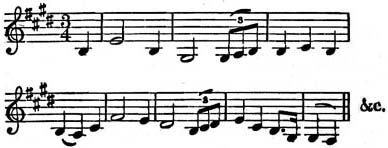
It seems to sound from afar, then draws near, getting louder. When at its loudest a figure suggestive of the Venusberg influence asserts itself and accompanies the hymn for a time, then disappears, leaving the religious strain to grow fainter and finally pass away in the distance, as the night falls. Now magic sights and sounds fill the air, a rosy mist floats before us, we hear exultant shouts and see a voluptuous dance -- the seductive spells of the Venusberg representing the evil principle:
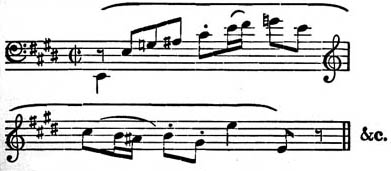
Tannhäuser, under the influence of this strain, sings his jubilant song of love:
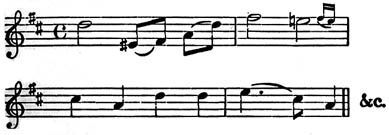
He is answered, first by strange and riotous cries, and then by the seductive voice of Venus herself, who appears and promises to fulfill his wildest dreams of bliss:
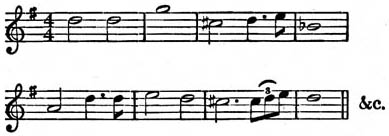
Again he sings his hymn in praise of the goddess, and is again answered by still more tumultuous shouts and savage cries of joy. Finally Venus carries Tannhäuser away to her abode of soul-destroying pleasure. The storm is laid, and only a soft breeze seems to stir the night air with a weird voluptuousness. Dawn breaks. Once more the pilgrims’ chant is heard in the distance, then nearer and nearer as the sun ascends; but the soft sighing of the breeze, which at first had suggested the wailing of condemned souls, rises too, and swells into tidings of great joy, proclaiming the salvation of the Venusberg itself, and joining the pilgrims’ chant in a chorus of redemption. All this, and much more, is in that glorious Overture, magnificent forecast of what is to come. Let us consider, in some detail, what follows, taking the music Act by Act.
FIRST ACT
At the very beginning of the opera, Wagner proclaimed his determination not to pander to the public taste at the expense of artistic conviction or dramatic requirement. He introduced the ballet in the opening scene, an arrangement without precedent and greatly resented at first, but in spite of protest the ballet retained its position. In this scene and the next we have reproduced with wonderful realistic power the atmosphere of "sultry sensuality" which lies over the Venusberg. The strains associated with Venus in the Overture are heard ever and anon till Tannhäuser regains his liberty, when the character of the music changes with the scene. The shepherd’s pipe and song are as refreshing to the ear as the quiet pastoral beauty of the landscape is to the eye. Then the chant of the pilgrims approaches, and as it dies away the sound of the hunting bugles introduces the Landgrave and Minstrels. During this third scene only male voices are heard, a fact which heightens the contrast between it and the preceding scenes, where the female element predominates. The septet which forms the finale to Act 1. is led up to by Wolfram in an exquisite melody which is heard later in the orchestra accompanying the voices.
SECOND ACT
In the first part of Act II. Wagner adheres more or less to the traditional lines of grand opera. The Act opens with a short orchestral prelude, and the curtain rises on the entrance of Elisabeth, whose greeting to the Hall of Song is well known in the concert-room. Her duet with Tannhäuser follows the Italian style, but at its close, while Elisabeth gazes after Tannhäuser’s departing figure, there is a beautiful Wagnerian touch in the introduction in the orchestra of the tender love theme, which opens the duet.
The tournament scene begins with the famous assembling march and chorus, in which the influence of Meyerbeer and the old school is obvious. The songs of the three knights are finely expressive of their respective sentiments, while Tannhäuser’s last outburst in praise of Venus is a repetition of his song in the First Act. The working out of this scene is truly marvellous. The spiritual beauty of the songs of Wolfram and Walther, the martial ardour of Biterolf, the interruptions of Tannhäuser, the increasing dismay of the assembly at his growing excitement, culminating in general consternation and holy horror at the mention of Venus, the intercession of Elisabeth, the repentance of Tannhäuser, and the ray of hope which the pilgrims’ chant brings to his remorseful soul -- all are depicted with unerring dramatic instinct. The whole scene is remarkable for psychological subtlety and musical beauty, and in the magnificent finale, which it would be difficult to equal for dramatic force, we have the real Wagner untrammeled by convention.
THIRD ACT
The impressive orchestral prelude is based on themes already heard, with the additional motive of "Pardon" -- the Dresden Amen -- afterwards to play an important part in the scene of Tannhäuser’s pilgrimage:
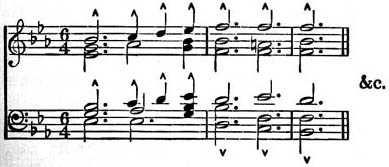
The Act commences with a short passage for Wolfram, after which we again hear the pilgrims’ chant. The beautiful prayer of Elisabeth is sometimes felt to be rather long, no doubt owing to the monotonous accompaniment of wood-wind alone, and also to the fact that only an exceptional artist can give it the requisite colour. At its close the orchestra reminds us of the presence of Wolfram, who has been watching Elisabeth at her devotions, by a reminiscence of his song in the tournament. He would guide her homeward, but by an expressive gesture she implies that her way now leads to heaven, at the same time thanking him for his attachment. This scene, in which not a word is uttered, but where the feelings of Elisabeth and wolfram are expressed entirely by gesture and by the orchestra, is one of the most pathetic ever written. To bring out its full meaning, however, the Elisabeth must be a great actress. Then follows the number which alone would prove that Wagner was a melodist of the very first rank, the exquisite "Address to the Evening Star," which has done so much to spread his name. The strains have scarcely died away when Tannhäuser enters, accompanied by a gloomy motive in the orchestra signifying that he has not received pardon:

His narrative, at first considered so wearisome, is now by common consent regarded as one of the most powerful passages in the opera, and perhaps for impressive declamation is unsurpassed by Wagner in any other work. In the last finale we have a splendid example of continuous dramatic development. The principal motives reappear, and the opera ends with pilgrims’ chant, now sung by all in a triumphal hymn of thanksgiving.
In his orchestration Wagner was an innovator, as in most other departments of his art. What Berlioz had done for concert works, he was doing for the stage. His scoring was different from any that had so far been heard in connection with opera. Many of his effects, now so generally adopted, were then fresh and somewhat startling; and his method of employing the brass individually and in combination, his elaborate subdivision of the strings, and other devices, came as a revelation of orchestral possibilities. In his later works he occasionally indulged his love of the novel and bizarre to excess, but in "Tannhäuser" his originality in this respect is displayed with discrimination.
His sense of colour, as exhibited here, is wonderful. He seldom fails to find the exact combination to represent the emotion he wishes to express. For instance, what could be more suggestive of the Venusberg than the wicked phrase for the violas, the wild "skirling" of the flutes, oboes, clarinets, &c., and the sensuous tremolos and shakes of the violins in their upper register! What a fine contrast all this presents to the low tones of the bassoons and horns, as the solemn strains of the Pilgrims’ Chorus fade away in the distance!
His strong feeling for light and shade is exemplified in the peaceful note of the solitary shepherd’s pipe, heard in the cool shade of the Wartburg valley, so refreshing after the sultry saturnalian atmosphere of the Grotto. In "Tannhäuser," too, Wagner shows the knack of throwing essentials into high relief. Though here this is occasionally achieved by means of what may be called musical padding, it is a point which he sometimes lost sight of in other works, where he was now and again over lavish in his elaboration of details.
As regards the old charge of lack of melody, the popularity of the Overture, of certain well-known excerpts, indeed of the whole opera, is sufficient refutation. If the melodic invention is not entirely free from mannerisms, it invariably shows originality.
To sum up, though rather unequal, exhibiting as it does both the strength and the weakness of the composer, "Tannhäuser" marked an epoch in the history of opera, and though professedly depreciated by Wagner himself in his later days, it will not be the least enduring monument to his memory.
Music With Ease | About Us | Contact Us | Privacy | Sitemap | Copyright | Terms of Use © 2005-25 musicwithease.com. All Rights Reserved. |
